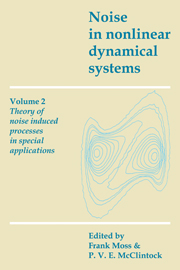Book contents
- Frontmatter
- Contents
- List of contributors
- Preface
- Introduction to Volume 2
- 1 Stochastic processes in quantum mechanical settings
- 2 Self-diffusion in non-Markovian condensed-matter systems
- 3 Escape from the underdamped potential well
- 4 Effect of noise on discrete dynamical systems with multiple attractors
- 5 Discrete dynamics perturbed by weak noise
- 6 Bifurcation behavior under modulated control parameters
- 7 Period doubling bifurcations: what good are they?
- 8 Noise-induced transitions
- 9 Mechanisms for noise-induced transitions in chemical systems
- 10 State selection dynamics in symmetry-breaking transitions
- 11 Noise in a ring-laser gyroscope
- 12 Control of noise by noise and applications to optical systems
- 13 Transition probabilities and spectral density of fluctuations of noise driven bistable systems
- Index
12 - Control of noise by noise and applications to optical systems
Published online by Cambridge University Press: 05 January 2012
- Frontmatter
- Contents
- List of contributors
- Preface
- Introduction to Volume 2
- 1 Stochastic processes in quantum mechanical settings
- 2 Self-diffusion in non-Markovian condensed-matter systems
- 3 Escape from the underdamped potential well
- 4 Effect of noise on discrete dynamical systems with multiple attractors
- 5 Discrete dynamics perturbed by weak noise
- 6 Bifurcation behavior under modulated control parameters
- 7 Period doubling bifurcations: what good are they?
- 8 Noise-induced transitions
- 9 Mechanisms for noise-induced transitions in chemical systems
- 10 State selection dynamics in symmetry-breaking transitions
- 11 Noise in a ring-laser gyroscope
- 12 Control of noise by noise and applications to optical systems
- 13 Transition probabilities and spectral density of fluctuations of noise driven bistable systems
- Index
Summary
Introduction
The consideration of multiplicative or colored noise in nonlinear dynamical systems has revealed a wide zoology of interesting phenomena (see, e.g., Graham and Schenzle, 1982; Hänggi, 1986; Horsthemke and Lefever, 1984; Sancho, San Miguel, Katz and Gunton, 1982; San Miguel and Sancho, 1981; Schenzle and Brand, 1979; Smythe, Moss and McClintock, 1983) which are well beyond the basic and classic picture that emerges from the linearized treatment (Van Kampen, 1961). In the framework of nonlinear systems, under special conditions, the presence of noise can give rise to striking qualitative deviations from the deterministic (i.e. noiseless) picture even for rather low noise levels (Broggi, Lugiato and Colombo, 1985). Furthermore, in the nonlinear domain a multiplicative noise or a colored noise can determine a behavior qualitatively different from that which arises from additive white noise; in some examples, these differences persist even in the small noise limit (Lugiato, Broggi and Colombo, 1986; Lugiato, Colombo, Broggi and Horowicz, 1986).
Modern optics provides a very appropriate framework to study not only nonlinear phenomena, but also noise effects. In fact, the theoretician can describe the behavior of optical systems by means of relatively simple models, that nonetheless are sufficiently realistic to allow a comparison with experimental data. On the other hand, in the field of optics it is possible to realize experiments on noise that allow a degree of control to some extent comparable to that attainable in analogous electronic experiments; an example is the observation of transient optical bimodality in optically pumped sodium vapor (Lange, Mitsche, Deserno and Mlynek, 1985; Mitsche, Deserno, Mlynek and Lange, 1985).
- Type
- Chapter
- Information
- Noise in Nonlinear Dynamical Systems , pp. 293 - 346Publisher: Cambridge University PressPrint publication year: 1989
- 3
- Cited by



